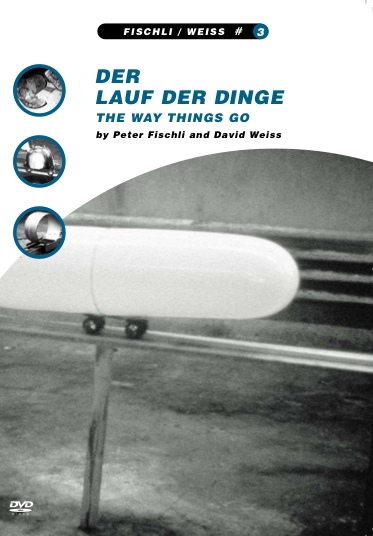In Peter Fischli & David Weiss’ «Der Lauf der Dinge», there is time to see exactly what happens. It is an extremly amusing, naturalistic film about cause and effect. One understands that the small crable would never have tipped if the fire had not burned long enough to make the liquid in the cradle evaporate sufficiently, and the fire would not have lit if the rolling ball had not struck the match against the striking surface, and the ball would never have rolled had not… It is a terrifically exciting film. What if the ball roles askew! If the balloon bursts too soon! What happens then? It must have taken hours, days of preparation to make everything work properly. In one take! At least I experience it as one single take; I cannot imagine that the artists have manipulated it – it would ruin the point. «Der Lauf der Dinge» is also inverse comedy. Downright slapstick. In films with Stanley Laurel & Oliver Hardy a great deal of the fun comes from the fact that everything is so predictable. If they paint a boat together, it is only to be expected that Hardy will step in a bucket full of paint sooner or later and be hit on the head by the boom. And quite rightly, this is what happens, and you get to see it. You don’t with Fischli & Weiss. But is it possible to imagine how many times things have gone wrong. In the last but one instant. How much annoyance Fischli & Weiss must have cried out at some physical or chemical margin of error. The fire goes out, or the ball roles back and is destroyed by the fire. All these possibilities make up an invisible film which is parallel to the film we see.
What we do get to see in Fischli & Weiss is thrilling in the ordinary Hitchcockian way, too. What is going to happen to that bag? How will that construction on the right react to the leaden weight that hangs in the thin thread above it? The artists have worked efficiently with light and darkness. Without one single actor, it is still very dramatic.
But. What is really happening? Isn’t it enough to have the events recounted? (A number of physical and chemical laws lead from one thing to another.) Do we have to see the film? Fairly quickly the idea behind becomes obvious, and from that point on it is as unlikely that something will go wrong as Clint Eastwood being gunned down in an ambush. Isn’t the film actually rather uninteresting. You get, and then well? Fischli & Weiss play the game that would amuse a child, and then they film what is obvious. They make a film in orderto document, out of necessity, since they want to be able to show the «event» to other people.
A strange quality in the film is that it seems to be able to entice again and again. Although we know what will happen in gangster, love or spy films, we see them over and over again. The godfather and the Russian die; everything goes back to normal and stants over; and the lovers get one another at the end. The good side wins if it is a Hollywood film; if it is European, things will be a bit more complicated.
Fischli & Weiss problematise this figure. The dramaturgy of «Der Lauf der Dinge» is extremely predictable, but still so captivating that we have to see it to the end. As soon as things begin to happen on the screen, expectations awake in the viewers. We want to be entertained, surprised, perhaps become smarter. And we want to know how it ends. The temporality in an ordinary feature film involves a lot of possibilites: the hero might choose to steal a car to catch up with the train, but not just any car, and he must be sure that the jewels are actually on that train, and he cannot know that until he has spoken to the woman who owns them and who took the bus in the other direction a moment ago. Is she involved? If he reflects too long everything might be to late.
In «Der Lauf der Dinge» nothing may happen too late, or too soon. Everything happens only when it can happen. There are no choices, no psychology, and strictly speaking no beginning or end. The film describes a movement that claims to be eternal. In films with subdued or non- existent plot, the atmosphere is usually significent. The form acquires as great a weight as the content. What is important is how and when things are said, how the director has chosen to light the set, cut the scenes and the location of the filming etc. But is there even an atmosphere in Fischli & Weiss’s film? Doesn’t it really describe a dead world in totally ludicrously uncompromising terms. A closed system. A system that is completely unchangeable as long as no one stops in. It is impossible to influence the uncanny consistency of the way of things, which seems to suggest a basic condition, an order of nature which only chaos can disturb. What is good about «Der Lauf der Dinge» is the fact that it actually become a film, that the event did not stop being an event. As the critical and bare skeleton of so many films, it is that chaos which the nature of culture only does well to be disturbed by.
Per Engström
Reprint by courtesy of the author, from: Paletten, 1/96, Nr 224, pp. 59, 60
© 2000 Kunstverlag Ingvild Goetz GmbH, Sammlung Goetz, Authors, Artists

Short feature, CH 1987, 16mm, 30′
Directors
Peter Fischli, David Weiss
Production
T&C Film Zurich
Worldsales
T&C Edition Zurich




























































































































































